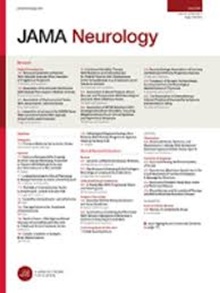多发性硬化症的并发症和疾病活动性
IF 20.4
1区 医学
Q1 CLINICAL NEUROLOGY
引用次数: 0
摘要
重要性多项研究表明,合并症会使多发性硬化症(MS)的临床相关结果恶化,包括诊断时的残疾严重程度和诊断后的残疾恶化率。然而,人们对合并症与疾病活动性指标(如复发率和磁共振成像病变累积)之间的关系知之甚少,而这些指标与临床医生和临床试验人员息息相关。目的 评估在多发性硬化症患者中进行的疾病修饰疗法(DMT)临床试验中合并症与疾病活动性之间的关系。设计、设置和参与者这项队列研究采用了两阶段荟萃分析方法,研究对象为2001年11月至2018年3月期间进行的MS DMTs 3期临床试验中随访2年的个体参与者数据。数据分析时间为2023年2月至2024年6月。暴露疾病负担和试验入组时存在的个体合并症,包括高血压;高脂血症;功能性心血管疾病、缺血性心脏病、脑血管疾病和外周血管疾病;糖尿病;自身免疫性甲状腺和其他自身免疫性疾病;偏头痛;肺部和皮肤疾病;抑郁症;焦虑症;以及其他精神疾病。主要结果和测量指标主要结果是随访2年的疾病活动证据(EDA),定义为经证实的复发活动、残疾恶化或磁共振成像上的任何新病变。结果17项临床试验共纳入16 794名多发性硬化症患者(67.2%为女性)。在为期两年的随访中,61.0%(95% CI,56.2%-66.3%;I2 = 97.9%)的汇总试验结果显示存在 EDA。对多种因素进行调整后,与无合并症相比,存在 3 种或更多合并症与 EDA 风险增加有关(调整后风险比 [AHR],1.14;95% CI,1.02-1.28)。与无心脏代谢合并症相比,患有 2 种或 2 种以上心脏代谢疾病也与 EDA 风险增加有关(调整风险比为 1.21;95% CI 为 1.08-1.37)。结论和相关性在这项研究中,并发症负担较重与多发性硬化症患者较差的临床预后有关,尽管并发症有可能是其他不良预后因素的部分介导因素。我们的研究结果表明,所调查的合并症与多发性硬化症的疾病活动有很大的不良关联,因此合并症的预防和管理应成为临床实践中亟待解决的问题。本文章由计算机程序翻译,如有差异,请以英文原文为准。
Comorbidity and Disease Activity in Multiple Sclerosis
ImportanceMultiple studies suggest that comorbidity worsens clinically relevant outcomes in multiple sclerosis (MS), including the severity of disability at diagnosis and rate of disability worsening after diagnosis. However, less is known regarding the association of comorbidity with measures of disease activity, such as relapse rate and magnetic resonance imaging lesion accrual, which are relevant to clinicians and clinical trialists.ObjectiveTo evaluate the association of comorbidities with disease activity in clinical trials of disease-modifying therapies (DMTs) in populations with MS.Design, Setting, and ParticipantsA 2-stage meta-analytic approach was used in this cohort study of individual participant data from phase 3 clinical trials of MS DMTs that had 2 years of follow-up and were conducted from November 2001 to March 2018. Data were analyzed from February 2023 to June 2024.ExposureComorbidity burden and individual comorbidities present at trial enrollment, including hypertension; hyperlipidemia; functional cardiovascular disease, ischemic heart, cerebrovascular, and peripheral vascular disease; diabetes; autoimmune thyroid and miscellaneous autoimmune conditions; migraine; lung and skin conditions; depression; anxiety; and other psychiatric disorders.Main Outcomes and MeasuresThe main outcome was evidence of disease activity (EDA) over 2 years of follow-up, defined as confirmed relapse activity, disability worsening, or any new lesions on magnetic resonance imaging.ResultsA total of 16 794 participants with MS were included from 17 clinical trials (67.2% female). Over the 2-year follow-up, 61.0% (95% CI, 56.2%-66.3%; I 2 = 97.9%) of the pooled trials had EDA. After adjusting for multiple factors, the presence of 3 or more comorbidities was associated with an increased hazard of EDA (adjusted hazard ratio [AHR], 1.14; 95% CI, 1.02-1.28) compared with no comorbidity. Presence of 2 or more cardiometabolic conditions was also associated with an increased hazard of EDA (AHR, 1.21; 95% CI, 1.08-1.37) compared with no cardiometabolic comorbidity. Presence of 1 psychiatric disorder was associated with an increased hazard of EDA (AHR, 1.07; 95% CI, 1.02-1.14).Conclusions and RelevanceIn this study, a higher burden of comorbidity was associated with worse clinical outcomes in people with MS, although comorbidity could potentially be a partial mediator of other negative prognostic factors. Our findings suggest a substantial adverse association of the comorbidities investigated with MS disease activity and that prevention and management of comorbidities should be a pressing concern in clinical practice.
求助全文
通过发布文献求助,成功后即可免费获取论文全文。
去求助
来源期刊

JAMA neurology
CLINICAL NEUROLOGY-
CiteScore
41.90
自引率
1.70%
发文量
250
期刊介绍:
JAMA Neurology is an international peer-reviewed journal for physicians caring for people with neurologic disorders and those interested in the structure and function of the normal and diseased nervous system. The Archives of Neurology & Psychiatry began publication in 1919 and, in 1959, became 2 separate journals: Archives of Neurology and Archives of General Psychiatry. In 2013, their names changed to JAMA Neurology and JAMA Psychiatry, respectively. JAMA Neurology is a member of the JAMA Network, a consortium of peer-reviewed, general medical and specialty publications.
 求助内容:
求助内容: 应助结果提醒方式:
应助结果提醒方式:


